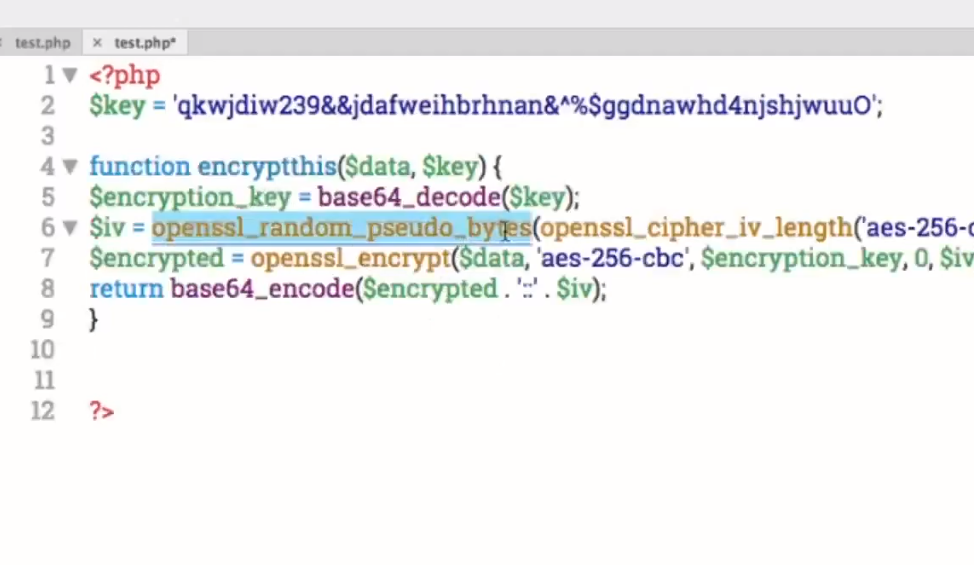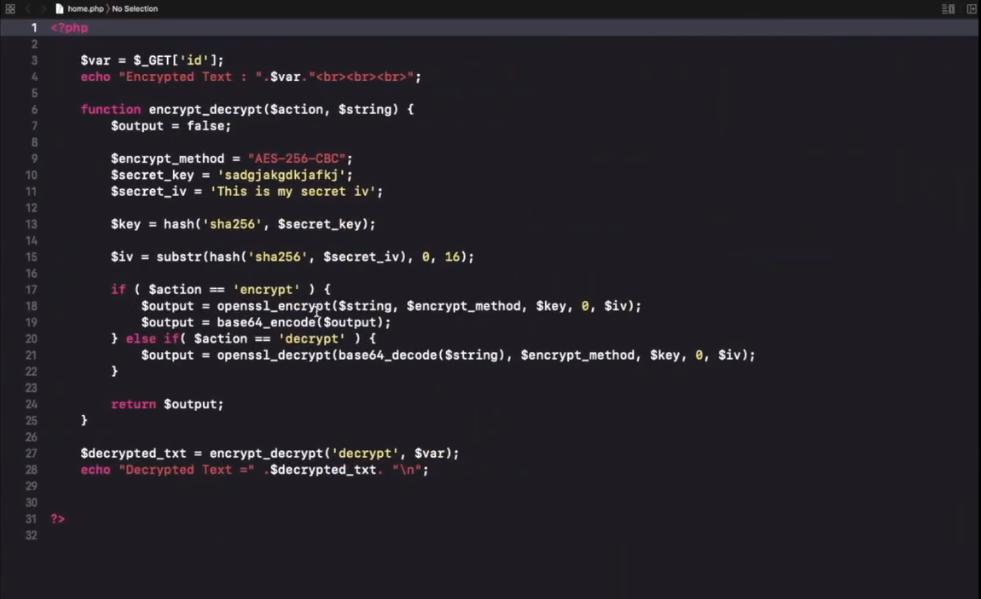Importance of Data Encryption in PHP

Data encryption in PHP is of utmost importance for several reasons:
1. Data Security: Encryption ensures that sensitive data is protected from unauthorized access. It converts plain text into ciphertext, which can only be decrypted with the correct encryption key. This helps to keep data confidential and secure, especially when it is stored or transmitted.
2. Compliance with Privacy Regulations: Many countries and industries have strict regulations regarding the protection of personal and sensitive data.
Understanding Data Encryption
Data encryption is the process of converting plain text into ciphertext to protect sensitive data from unauthorized access. It is important for several reasons:
1. Data Security: Encryption ensures that sensitive data is protected from unauthorized access. It converts plain text into ciphertext, which can only be decrypted with the correct encryption key. This helps to keep data confidential and secure, especially when it is stored or transmitted.
2. Compliance with Privacy Regulations: Many countries and industries have strict regulations regarding the protection of personal and sensitive data.
Generating Encryption Keys
Generating encryption keys is a crucial step in implementing encryption. Encryption keys are used to encrypt and decrypt data and their strength is essential for ensuring the security of the encryption process.
Encryption Keys And Their Role
Encryption keys play a vital role in the encryption process. They are used to both encrypt and decrypt data, ensuring its confidentiality and security. Generating strong encryption keys is essential for effective encryption.
Encrypting Data
To encrypt data, you need to use an encryption key. This key is a unique sequence of characters that is used to scramble the data into an unreadable format. The strength of the encryption key directly impacts the security of the encrypted data. Strong encryption keys are generated using complex algorithms and are typically long and random, making them difficult to guess or crack.
Encrypting Individual Data Elements
Encrypting individual data elements requires the use of encryption keys. These keys are essential for effective encryption as they are used to scramble the data into an unreadable format. It is important to use strong encryption keys, which are generated using complex algorithms and are typically long and random. Strong encryption keys significantly enhance the security of the encrypted data by making them difficult to guess or crack.
Strategies For Encrypting Databases And Files
There are several strategies for encrypting databases and files:
1. Full Database/File Encryption: This strategy involves encrypting the entire database or file, including all data elements within it. This provides a high level of security as all the data is protected. However, it can also impact performance, as the entire database or file needs to be decrypted for any operations to be performed.
2. Column-Level Encryption: In this strategy, only specific columns or data elements within the database or file are encrypted.
User Authentication and Data Encryption
User Authentication and Data Encryption: This approach focuses on securing user authentication and encrypting sensitive data. It involves implementing strong authentication mechanisms, such as multi-factor authentication, to verify the identity of users accessing the system. Additionally, sensitive data is encrypted to protect it from unauthorized access. This strategy provides a balance between security and performance, as only specific data elements are encrypted, reducing the impact on system operations.
Incorporating User Authentication in Encryption
Incorporating user authentication in encryption is a crucial aspect of securing sensitive data. By combining these two techniques, organizations can ensure that only authorized users can access the encrypted data. One common approach is to use a technique called “symmetric encryption with user-specific keys.” In this method, each user is assigned a unique encryption key that is used to encrypt and decrypt their data. The user’s authentication credentials, such as a username and password, are used to generate and securely store their encryption key.
Strengthening Data Security With User-Specific Encryption
By implementing user-specific encryption, organizations can enhance data security in the following ways:
1. Access Control: With user-specific encryption, only authorized users can access the encrypted data. Each user is assigned a unique encryption key, which acts as a digital lock for their data. Without the correct key, unauthorized users cannot decrypt the data, ensuring that sensitive information remains protected.
2. User Authentication: User-specific encryption incorporates authentication credentials, such as usernames and passwords, to generate and securely store encryption keys.
Encryption Best Practices

1. Strong Encryption Algorithms: It is important to use strong encryption algorithms that are resistant to attacks. Popular choices include AES (Advanced Encryption Standard) and RSA (Rivest-Shamir-Adleman).
2. Key Management: Proper key management is essential for user-specific encryption. This includes securely storing and distributing encryption keys, as well as regularly rotating them to minimize the risk of unauthorized access.
3. Regular Auditing: Regularly auditing encrypted data can help identify any vulnerabilities or weaknesses in the encryption system. This can involve reviewing access logs, monitoring for unusual activity, and conducting penetration testing.
4. Encryption at Rest and in Transit: It is important to encrypt data both at rest (when stored on servers or devices) and in transit (when being transmitted over networks). This ensures that data remains protected at all times, regardless of its location.
Future of Data Encryption in PHP

The future of data encryption in PHP is promising. As technology advances, there will likely be more robust encryption algorithms and techniques available for use in PHP. Additionally, there may be an increased emphasis on encryption standards and best practices in web development, leading to improved security measures in PHP applications. Developers need to stay updated on the latest encryption advancements and implement them effectively to ensure the protection of sensitive data.
FAQs (Frequently Asked Questions)
What is data encryption, and why is it important in PHP?
Data encryption is the process of converting plaintext data into ciphertext, making it unreadable to unauthorized users. In PHP, data encryption is important for several reasons:
1. Confidentiality: Encryption ensures that sensitive information remains confidential and cannot be accessed by unauthorized individuals.
2. Data Integrity: Encryption can also be used to verify the integrity of the data. By encrypting data, any unauthorized modifications or tampering can be detected.
How can I generate strong encryption keys in PHP?
To generate strong encryption keys in PHP, you can use the openssl_random_pseudo_bytes() function. This function generates a string of pseudo-random bytes, which can be used as encryption keys. Here’s an example:“`php
$key = openssl_random_pseudo_bytes(32);
“`
In this example, the openssl_random_pseudo_bytes() function generates a 32-byte key. You can adjust the length of the key by changing the parameter value.
Is it possible to encrypt existing data in a PHP application?
Yes, it is possible to encrypt existing data in a PHP application. PHP provides several encryption functions that you can use to encrypt and decrypt data. One commonly used encryption function is openssl_encrypt(). Here’s an example of how you can use it to encrypt data:“`php
$data = “Hello, world!”;
$key = “mysecretkey”;
$encryptedData = openssl_encrypt($data, “AES-256-CBC”, $key, 0, “1234567890123456”);
“
What encryption algorithm should I use in PHP?
In PHP, there are several encryption algorithms that you can use depending on your specific requirements. Some commonly used encryption algorithms in PHP include:
1. AES (Advanced Encryption Standard): AES is a symmetric encryption algorithm that is widely used for encrypting sensitive data. It supports different key lengths, such as AES-128, AES-192, and AES-256.
2. Blowfish: Blowfish is a symmetric-key block cypher that can be used for encryption and decryption.
How can I securely transmit encrypted data over networks?
To securely transmit encrypted data over networks, you can follow these steps:
1. Use a secure encryption algorithm: Choose a strong encryption algorithm like AES or Blowfish to encrypt your data. These algorithms provide a high level of security.
2. Generate a strong encryption key: Use a secure random number generator to generate a strong encryption key. The key should be long and complex to make it difficult to guess.
What are the best practices for managing encryption keys?
Best practices for managing encryption keys include:
1. Key Generation: Use a secure random number generator to generate encryption keys. Ensure that the keys are long and complex enough to resist brute-force attacks.
2. Key Storage: Store encryption keys in a secure location, such as a hardware security module (HSM) or a trusted key management system. Avoid storing keys in plaintext or easily accessible locations.
3. Key Rotation: Regularly rotate encryption keys to minimize the impact of a compromised key.
How can I ensure cross-platform compatibility for encrypted data?
To ensure cross-platform compatibility for encrypted data, you can follow these steps:
1. Use standard encryption algorithms: Choose encryption algorithms that are widely supported across different platforms. Common encryption algorithms such as AES (Advanced Encryption Standard) are generally compatible with various operating systems and programming languages.
2. Implement platform-independent encryption libraries: Utilize encryption libraries or frameworks that are designed to work across different platforms.
Conclusion
In conclusion, data encryption in PHP is a promising area that will continue to evolve as technology advances. Developers should stay informed about the latest encryption algorithms and techniques to enhance the security of PHP applications and protect sensitive data effectively.
